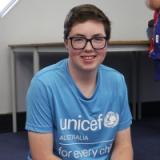Do you wear clothing? Do you want to change how clothing is designed, produced, shared and used? This is your chance to be part of innovating the fashion industry! Submit your solution by the 30th of June.
This challenge has finished
Do you want to change how clothing is designed, produced, shared and used? This is your chance to be part of innovating the fashion industry!
Globally, the fashion industry is worth over $1 trillion. It’s an exciting industry creating products that allow people to express themselves, help stay warm (or cool) and stay safe at work or doing the things they love! It also provides countless jobs across the world. However, it’s also an industry that creates a lot of waste and is under the spotlight for exploiting workers.
We want you to explore some of these challenges and develop solutions to innovate the fashion industry.
There are some great examples of innovation already in the fashion industry - throughout the challenge we’ll be sharing some great stories with you as inspiration for you to come up with your own ideas for creating change within the fashion industry!
Your challenge: How might we innovate the fashion industry to transform the way we create, purchase and use fashion for work, study and play?
This challenge will run until the 30th of June.
Within this challenge there are many different themes that can be explored. For example:
- Sustainability in fashion - looking at fabric production and consumption and how we create more sustainable fashion, ethical supply chains and reduce landfill and waste
- The role of technology in retail and fashion and how it helps consumers make better choices or improves their experience (bringing tech and fashion together to improve people’s lives)
- How fashion is part of our lives in different ways - from the clothes we work in, study in or “play” in. How might we improve clothing in every facet of our lives?
- How do we make fashion more inclusive - eg women in male-dominiated industries (or vice versa), for people with disabilities or for those with lower incomes.
- Identity and culture: looking at how fashion is an enabler for creating expressions of culture and identity as well as advocating through fashion.
For this challenge we ask you to focus on one of these themes!
What is the challenge?
The Future of Fashion challenge is a free online design thinking challenge that empowers you to explore the fashion industry, identify problems, and develop innovative ways to address these. The focus is on How might innovate the fashion industry to transform the way we create, purchase and use fashion?
How do I participate?
This is a challenge you can do on your own or with a friend, team or family member. It can also be run by your teachers or parents.
Will I get feedback?
If you submit your solution by the 30th of April you will get feedback to help you develop your idea!
Why is this important now?
We’re living in a time that has incredible technological advancement as well as more conscious, engaged citizens that want to see companies making ethical choices and reducing waste. The fashion industry is rapidly evolving and now is the time to encourage change in an industry that has the potential to help millions of people!
Who are we?
Young Change Agents is a not-for-profit social enterprise that empowers young people across Australia to find problems in their community, reframe them as opportunities, and then come up with solutions. By running online events like this we want to support young people like yourselves to be Young Change Agents!
What are the prizes?
There are two categories
1. 10-15 years old's (3 winners will be chosen)
2. 16-21 year old's (3 winners will be chosen)
The winners will receive the following per idea/team:
- An awesome JBL Flip Essential Portable Bluetooth Speaker (or a voucher if there are multiple people in your team)
- A virtual mentoring package from Young Change Agents (2 x 1 hr sessions)
- Plus the opportunity to be featured on our website and in our top ideas media campaign!
- 14 runners-up will also receive a special reward for taking part and be featured on our site as a runner-up!
- One selected team will also win a $100 Voucher from Citizen Wolf!
How is the challenge structured?
1. Choose a "how might we" to focus on - this could be one of the ones we shared above or one you’ve developed yourself. You can also choose to focus on this theme in your home, your school, or your community.
2. You then need to deep dive into the challenge area you’ve chosen. This will help you find out why the problem is happening in that context. To do this you need to ask the question, “why” and then ask “why?” again until you get to what we call the “root cause” or the bottom of the problem.
For example:
You have chosen the challenge “sustainability in production and consumption”
“Why is there clothing waste?”
Because people lose weight and their clothes don't fit
Why?
Because they don't know how to adapt them or it seems like a hassle to do that.
Why?
Because it's easier to just buy new clothes
Aha! So what if we made it easier for people to tailor their existing clothes rather than buy new ones?
Of course, there are many reasons why there is clothes waste - you can pick lots of reasons and follow the same process to come up with a different root cause. In reality, solving problems needs to be done in m
3. Learn more about your problem
You can also discover more about a problem by conducting interviews. We call these “empathy interviews” because you are listening to someone talk about the problem and developing an understanding as to why this is a problem for them.
So, find a partner and ask them to tell you about this problem and how it affects them.
For example:
You have chosen the challenge area of “how might we improve the way society consumers fashion?” and be focusing on this in your school.
You might ask your friends questions like:
How often do you or your family buy clothes?
How much clothing waste in your home is there? For example, clothes that are never worn or get thrown out.
Why do you think clothes get bought but never worn?
At what point do you throw out/stop using your clothes?
Do you ever swap or share clothes with other people?
To create a solution that will have a positive impact you need to think about who is being affected by the problem. Whilst we are all impacted by the fashion industry, in the long run it’s important to be specific. Is it animals, workers, farmers, young people, families? Try and figure out who you want to help!
4. Reframe your problem and come up with some ideas
From your empathy interviews you will get interesting insights about some problems this person might have in helping to be part of the solution. For example, Sarah might use her clothes dryer everyday as her backyard is small and she doesn’t have space for a clothesline. You can then turn that into a, “how might we” question. For example,
how might we create a better clothes drying solution for small backyards?” or, “how might we better predict when clothes are dry in a dryer so we don’t overuse it?”
We do this because we like to think about opportunities rather than problems. This helps you to be creative and innovate, rather than focus on a negative situation.
Now you have your opportunity, it is time to be creative and come up with ideas! Get a notebook, post-its or some coloured paper and come up with as many ideas as you can. Imagine you have one million dollars and you can do anything you want. Imagine you had to use tech to do it. Then imagine you had no access to tech..what would you do? Push yourself to come up with at least ten different ideas. Then take a break and try and come up with even more! Think about your audience you chose and how you could best help them. Once you’ve got a lot of ideas choose the one you think would best solve your opportunity. This is your solution. Remember there’s no such thing as a bad idea.
5. Test the solution you have designed
Before you share your ideas or spend time building something, it’s a good idea to test and improve your ideas. This process is called validation. This could be done by talking to your parents about what you have created and asking for some feedback. You could even consult the target group you are trying to help (this may not work if you are helping animals) but as you get more feedback on your idea you can make it even better. Don’t forget to be Covid-19 safe and avoid close contact with people and use the internet and the phone where possible. Another great way to test is to create a prototype - this is a draft version of your idea. You can do this by drawing what your idea would look like, creating a mini-version, building something out of recycled materials, or creating a plan of what idea could look like. You can share photos of your prototype with your challenge entry!
6. Share!
Now that you’ve got an idea, we want to hear it! Click ‘sign up now to get started’ at the top of this page. Keep in mind we’ll ask you for a logo and a picture of your solution. This could be of your brainstorming, a picture of what your idea would look like, a poster promoting your idea or something else that is a visual representation of your idea.
Challenge Tips
Additional Resources
For Educators
Would you like us to run this as a challenge for your students? Get in touch to book a workshop! Or we can provide you with our classroom kit so you can run this as a 1-2 hour design-thinking challenge for your class.
For Parents (of Under 18 Entrants)
This is a great activity to do with your child to re-frame current challenges as an opportunity to problem-solve. You or your child will need to create an account to post their project idea! Point your child to this page to work through independently using the instructions to the left OR you can run this as a 90 min challenge at home using our worksheet and guide! T&C's on the sign-up form!
Special Guest Judges

Karina Kallio
Fashion designer and Sustainable Futures PhD researcher.

Crystal McGregor
CEO and CoFounder of Puctto

Sally Giblin
CEO & CoFounder of Pure Bundle

Zoltan Csaki
Co-Founder, Citizen Wolf

Franklin Hooper
Entrepreneur, Young Ambassador at UNICEF

Victoria Bailey
Garment Technician, Pomelo Fashion
